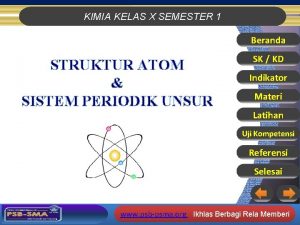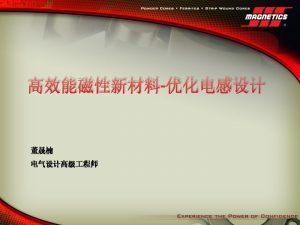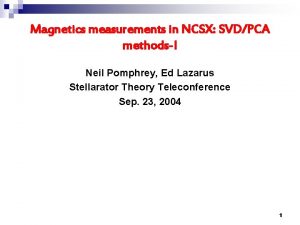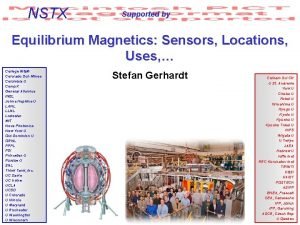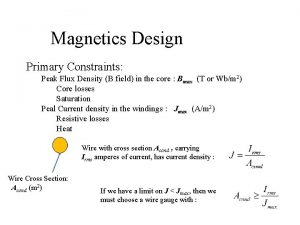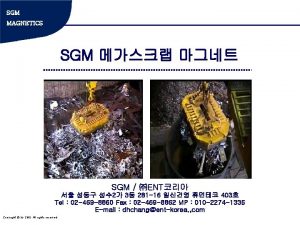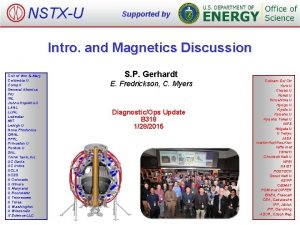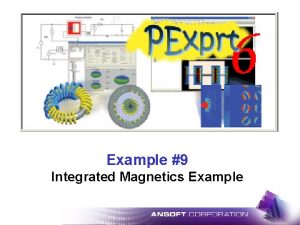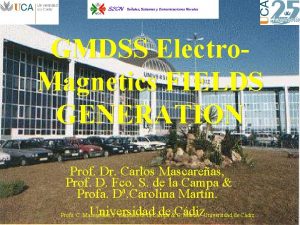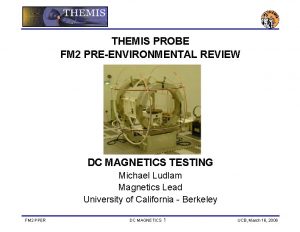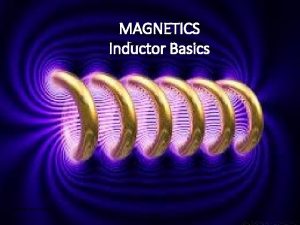PSMA Magnetics Committee Proposed Projects for 2008 2009



































- Slides: 35

PSMA Magnetics Committee Proposed Projects for 2008 -2009 1. Validate and promote new format for core loss data. 2. Validate, refine and promote SPICE model for transformers. Edward Herbert February, 2008

PSMA Magnetics Committee Proposed Projects for 2008 -2009 • The slides can be viewed at http: //fmtt. com/PSMAmag 1. ppt (note: file names are case sensitive) • The paper can be viewed at http: //fmtt. com, click the link for “Transformer Spice Model” (pdf, 1, 020 k), to view or download. 2

PSMA Magnetics Committee Proposed Projects for 2008 -2009 • Project 1. • Validate and promote new format for core loss data. 3

PSMA Magnetics Committee Proposed Projects for 2008 -2009 The graph on the right shows core loss data for Magnetics, Inc. material F. The blue lines are the original data. Magnetics, Inc. also provides core loss approximation formulae: m. W/cm 3 Where a, c and d are constants, f is in k. Hz and is in k. G. The dashed lines in the graph are the core loss approximations, color coded. 4

PSMA Magnetics Committee Proposed Projects for 2008 -2009 Note the slopes of the lines. On a log-log graph, the slope is the exponent, “d”. Note the differences, almost 2 to 3. Note the line spacing. On a log-log graph, the spacing is the exponent, “c. Note the differences, almost 1 to 2. This shows that the loss mechanisms are different, and the slope is a clue as to which to use. 5

PSMA Magnetics Committee Proposed Projects for 2008 -2009 To be useful for SPICE, we need the core losses in the time domain. The same core loss data can be plotted vs frequency for curves of equal Bmax. Using the core loss approximation, and ramping the frequency, the solutions are shown on the graph on the right, color coded. The blue lines are my best approximation at curve fitting. No accuracy is claimed, this is a qualitative exercise. 6

PSMA Magnetics Committee Proposed Projects for 2008 -2009 It is interesting to divide the loss density vs frequency through by the frequency. This gives a graph of the loss density per cycle for various Bmax. Note that the curves are fairly flat on the left, indicating that frequency does not much affect the losses. This is the classic model, that the losses are fixed for a given Bmax. This breaks down above about 10 k. Hz. No accuracy is claimed, this is a qualitative exercise. 7

PSMA Magnetics Committee Proposed Projects for 2008 -2009 Substituting into the loss equation and solving for log steps of E gives the graph on the right, loss density vs frequency for E. Log steps of volt density, Volts per turn cm 2. No accuracy is claimed, this is a qualitative exercise. The solution is blanked for Bmax > 3, 000 gauss. 8

PSMA Magnetics Committee Proposed Projects for 2008 -2009 “d” varies from almost 2 to 3, “c” varies from almost 1 to 2. Using these as limits, asymptotes for the loss density vs frequency for log steps of voltage can be plotted. The fit is not too bad. Log steps of volt density, Volts per turn cm 2. No accuracy is claimed, this is a qualitative exercise. The solution is blanked for Bmax > 3, 000 gauss. 9

PSMA Magnetics Committee Proposed Projects for 2008 -2009 Making a left-right mirror image of the plot, frequency is converted to period. I chose to use the half-cycle on-time for the x axis, that is, the period of the pulse for an ac square-wave. This is NOT the instantaneous loss vs time, as the formulae are in terms of Bmax. We still need an expression in the time domain for a SPICE model. This curve may be very useful for the design of transformers, especially pwm transformers. No accuracy is claimed, this is a qualitative exercise. Log steps of volt density, Volts per turn cm 2 vs “on-time” for ac square waves. The solution is blanked for Bmax > 3, 000 gauss. 10

PSMA Magnetics Committee Proposed Projects for 2008 -2009 Proposed presentation for core loss data: Core loss data presented as loss density vs on-time for log steps of volt density should be easier to generate, and should be more useful to transformer designers. Hypothesis: I believe that a more accurate result for pwm transformers is to use the actual voltage and on-time of the pulse. Find the loss density from the graph, then factor it by the duty-cycle D. PL = PL(E, t) * D For 100 volts on 10 turns on a core of 2 cm 2, use the 5 V line (100 V / 10 * 2). No accuracy is claimed, this is a qualitative exercise. Log steps of volt density, Volts per turn cm 2 vs “on-time” for ac square waves. The solution is blanked for Bmax > 3, 000 gauss. 11

PSMA Magnetics Committee Proposed Projects for 2008 -2009 To get an expression that is useful in SPICE, the data must be converted to the time domain. The graph at the left plots loss density for a family of square wave on-times with 100 m. V per turn cm 2. Sorting out what it means, it really is a crude step-wise integration. So, the time the expression in the time domain is the derivative of the curve. No accuracy is claimed, this is a qualitative exercise. 12

PSMA Magnetics Committee Proposed Projects for 2008 -2009 Taking the derivative of the curve is daunting, as I do not have an expression for it. However, taking the derivative of the asymptotes is easier. No accuracy is claimed, this is a qualitative exercise. Thus, the high frequency SPICE model for core loss is just a resistor. 13

PSMA Magnetics Committee Proposed Projects for 2008 -2009 No accuracy is claimed, this is a qualitative exercise. Thus, the low frequency SPICE model for core loss is a resistor, but a special resistor that varies as 1/B. 14

PSMA Magnetics Committee Proposed Projects for 2008 -2009 • Project 2. • Validate, refine and promote SPICE model for transformers. 15

PSMA Magnetics Committee Proposed Projects for 2008 -2009 • Basic ideal transformer: 16

PSMA Magnetics Committee Proposed Projects for 2008 -2009 Multiple-winding ideal transformers: A separate ideal transformer model is made for each winding, and they are connected through a “linking winding” at the terminals Vc. If two or more windings are connected to make a tapped winding, it is preferred to model each winding separately, then connect them through a low resistance, to preserve the node names. R 13 connects V 1 r to V 2. 17

PSMA Magnetics Committee Proposed Projects for 2008 -2009 • Magnetizing inductance, saturation and hysteresis, Simple model: 18

PSMA Magnetics Committee Proposed Projects for 2008 -2009 • Curve fitting: Lm is varied to adjust the slope of the curve at the origin. Use the measured or estimated magnetizing inductance. 19

PSMA Magnetics Committee Proposed Projects for 2008 -2009 • Curve fitting: The exponent is varied to adjust the corner of the curve as the core saturates. 20

PSMA Magnetics Committee Proposed Projects for 2008 -2009 • Curve fitting: Rh is varied to adjust the width of the hysteresis loop. Adjust Lm, the exponent and Rh as necessary to get a good approximation. 21

PSMA Magnetics Committee Proposed Projects for 2008 -2009 SPICE model, 4 turn transformer with hysteresis and core losses, simple model: The hysteresis and core loss model is connected to the transformer through the “core” connection, Vc and the return. If the transformer has turns connected to make a centertapped winding, it is preferred to connect them through a very low value resistor, so the node names do not change. 22

PSMA Magnetics Committee Proposed Projects for 2008 -2009 SPICE model: Winding resistance and leakage inductance, simple model; Loss and energy test points. For a simple model, the winding loss is modeled as a resistor, and the leakage inductance is modeled as an inductor. Behavioral voltage sources calculate the losses and stored energy in the various components. 23

PSMA Magnetics Committee Proposed Projects for 2008 -2009 Thus, the high frequency SPICE model for core loss is just a resistor. Core loss, low and high frequency effects. Thus, the low frequency SPICE model for core loss is a resistor, but a special resistor that varies as 1/B. 24

PSMA Magnetics Committee Proposed Projects for 2008 -2009 Core loss, low and high frequency effects. 25

PSMA Magnetics Committee Proposed Projects for 2008 -2009 Core loss, low and high frequency effects. Curve fitting; The hysteresis curves show the effect of varying Rb. To start, Rb is set to a very high value, 1 e 6. The green graph shows the effect of Rh. The blue graph shows Rb = 0. 1 . The red graph shows Rb = 0. 05 . Note that the hysteresis loop fattens as a wedge as Rb is decreased. 26

PSMA Magnetics Committee Proposed Projects for 2008 -2009 Skin effect: A wire is modeled as five concentric segments of equal area. Because the area is equal, the dc resistances are equal, and are 5 x the dc resistance of a wire per a wire table, in m per unit length times the length. 27

PSMA Magnetics Committee Proposed Projects for 2008 -2009 Skin effect: The wire size (AWD or mm), wire length and temperature are entered as SPICE parameters. The resistance Rw 1 is calculated in the behavioral voltage sources. The inductors are the value that gives the correct time constant for the depth, given the resistance. The inductances seem to be independent of wire size, at least approximately. 28

PSMA Magnetics Committee Proposed Projects for 2008 -2009 Proximity effects: A step change in current I 1 induces an equal and opposite current Ie in an adjacent conductor. The current Ie dies out exponentially. Rigorously, a coupled inductor and a wire with skin depth should be modeled, but that is pretty complex. The SPICE model on the right is a reasonable approximation, and is quite simple. However, the loss in Rw is NOT Ir 12 * Rw, it is (Ie 2 + I 12) * Rw. In the simple model, Rw is also a surrogate for Re, so the calculation must recognize the two resistors of the more complex model. The voltage drop, Ir 1*Rw is correct. 29

PSMA Magnetics Committee Proposed Projects for 2008 -2009 Proximity effect: A step change in a current I 1 induces an equal and opposite current Ie in an adjacent wire. Ie dies out exponentially. The waveform of Ie is modeled below as Vjd, for use in a behavioral current source, scaled appropriately. If the shape is not quite right, a different filter can be used in place of C 1 R 1. 30

PSMA Magnetics Committee Proposed Projects for 2008 -2009 Proximity effects: Assuming that the eddy currents are mostly on the surface of the conductor, the exponential current transient is applied to the outer layer resistor R 1 of the model for the skin effect, scaled if necessary. The parameters are adjusted to fit measured circuit behavior if it is available. 31

PSMA Magnetics Committee Proposed Projects for 2008 -2009 Proximity effect: The currents in the layers are shown, and the total winding losses Pw. Note that some currents go the “wrong” way following a transient, and that some currents and losses persist after the input current goes to 0. 32

PSMA Magnetics Committee Proposed Projects for 2008 -2009 Proximity effects, multi-layer windings; For a multi-layer winding, model each layer as a separate wire with proximity effects, all connected in series. The injected current transient increases for each layer, approximately as 1 x, 2 x, 3 x, etc. Proximity effects, losses in another winding or a shield; The losses are modeled in the winding in which the current changes, and can be approximated by increasing the injected current Ie. If the winding is a multi-layer winding, assume that the losses are only in the layer adjacent to the other winding or the shield. 33

PSMA Magnetics Committee Proposed Projects for 2008 -2009 Transformers with coaxial or interleaved windings: The simple models given above are not adequate for modeling the leakage inductance and proximity effects in coaxial and interleaved windings. In the top core on the right, the first primary has very good coupling to its coaxial secondary, and it is similar for the second primary to the its coaxial secondary. However, the coupling from primary to primary has a much higher leakage inductance, important for an accurate SPICE model. 34

PSMA Magnetics Committee Proposed Projects for 2008 -2009 Transformers with coaxial or interleaved windings: The behavioral current and voltage sources B 1 and B 2 model the first primary and its coaxial secondary winding. The leakage inductances are very low. Similar for B 3 and B 4. The secondaries link through a higher inductance, L 6 and L 7, center-tapped for symmetry, and winding resistance R 9 and R 10. The leakage inductance primary to primary reflects this higher inductance, while each primary to its coaxial secondary winding is very low. An interleaved transformer is modeled similarly. 35
 Www.psb-psma.org sejarah
Www.psb-psma.org sejarah Www.psb-psma.org kimia
Www.psb-psma.org kimia Psma f18
Psma f18 2008-2009 school year
2008-2009 school year 2008 2008
2008 2008 Yashpal committee report 1993 pdf
Yashpal committee report 1993 pdf Variansen formel
Variansen formel Ledarskapsteorier
Ledarskapsteorier Atmosfr
Atmosfr Vilotidsbok
Vilotidsbok Rutin för avvikelsehantering
Rutin för avvikelsehantering Presentera för publik crossboss
Presentera för publik crossboss Fspos vägledning för kontinuitetshantering
Fspos vägledning för kontinuitetshantering Hur skriver man en debattartikel
Hur skriver man en debattartikel Var 1721 för stormaktssverige
Var 1721 för stormaktssverige Tobinskatten för och nackdelar
Tobinskatten för och nackdelar Tillitsbaserad ledning
Tillitsbaserad ledning Bunden poesi
Bunden poesi Hur ser ett referat ut
Hur ser ett referat ut Varför kallas perioden 1918-1939 för mellankrigstiden?
Varför kallas perioden 1918-1939 för mellankrigstiden? Programskede byggprocessen
Programskede byggprocessen Mjälthilus
Mjälthilus Arkimedes princip formel
Arkimedes princip formel Förklara densitet för barn
Förklara densitet för barn Elektronik för barn
Elektronik för barn Texter för hinduer tantra
Texter för hinduer tantra Big brother rösta
Big brother rösta Tack för att ni har lyssnat
Tack för att ni har lyssnat Skivepiteldysplasi
Skivepiteldysplasi Borra hål för knoppar
Borra hål för knoppar Anatomi organ reproduksi
Anatomi organ reproduksi Smärtskolan kunskap för livet
Smärtskolan kunskap för livet Vad är ett minoritetsspråk
Vad är ett minoritetsspråk Typiska drag för en novell
Typiska drag för en novell Magnetsjukhus
Magnetsjukhus Humanitr
Humanitr

